This West Coast brand has invested in a new design and new talent, setting the stage for the chain’s eastward march.
Pizza is the ultimate takeout and delivery food. It’s been that way since before third-party delivery, before the internet, back to a time when people would save pizza coupons from the Sunday newspaper to use the next weekend. You can see this today in how most pizza chains operate: a kitchen, a counter, no seats. People — either delivery drivers or customers — come in, pick up a pie and drive away.
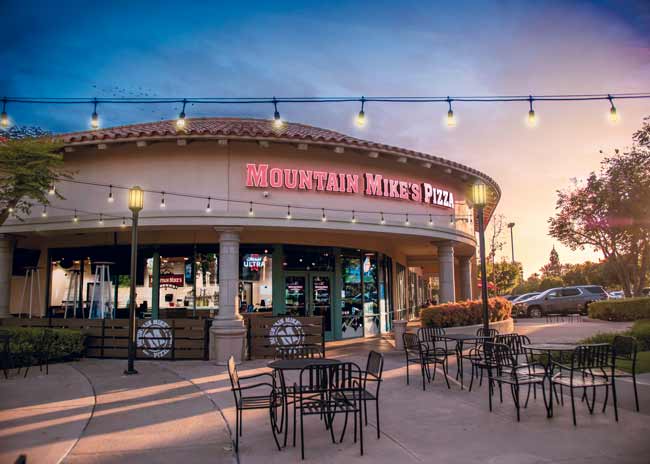
Mountain Mike’s Pizza, a 44-year-old California-based chain with nearly 270 locations in the Western U.S., doesn’t work that way. Sure, the chain has a robust takeout and delivery business. Combined takeout and delivery accounts for about 75% to 80% of Mountain Mike’s revenue. But the brand focus extends beyond food to-go.
“We are all about bringing communities, sports fans, and families together to celebrate around the best pizza in the whole world,” says Mountain Mike’s president and chief operating officer Jim Metevier.
Community, celebration, coming together. Those aren’t words associated with off-premises dining. Mountain Mike’s, then, lives out its brand promise with a dining area that’s more than a few seats in an open area.
“For us, we really feel like [our dine-in offering] is a brand differentiator,” Metevier says. “We want to be very involved in our communities. The only way you can do that is to have a space where people can come together and meet.”
To fulfill this brand promise, to live up to its stated identity, Mountain Mike’s introduced a new design in 2020. This creation helps unify the appearance of a chain that has had 40-plus years of growth, improves operational efficiency and, perhaps most importantly, gives customers a reason to sit down, have some pizza and maybe a drink, and enjoy being out with others.
Metevier acknowledges this approach runs counter not just to the pizza sector, but to the trend in the overall restaurant industry. Many concepts are shrinking their dining areas or even eliminating them altogether in favor of locations with drive-thrus and walk-up pickup windows. This, however, creates an opening for businesses that continue to offer dine-in and especially a dine-in experience.
Bringing People Together
Community, family and sport. Those pillars listed by Metevier naturally play a big role in Mountain Mike’s new design. Most obviously, the design includes televisions. Each Mountain Mike’s location features multiple flat-screens, some placed above booths, and one above the chain’s bar, which offers beer and wine. Combine this with the communal nature of pizza, and Mountain Mike’s is designed for people who want to catch a game.
This ties into the community- and family-oriented nature of Mountain Mike’s. Flexible seating lets Mountain Mike’s restaurants accommodate large groups such as Little League teams. Locations also include private rooms for special events. The new design also has a game room, providing a space to keep kids happy while parents enjoy their pizza and watch a game themselves. These elements, combined, give people a reason not just to order from Mountain Mike’s, but to visit, says Metevier.
“We are focusing on dine-in as a brand differentiator,” says Metevier. “It’s supply and demand. The places that offer [a good dine-in experience] are going away, so there is less and less available. For us, we focus on community engagement and being the place to go. It is your local hangout.”
The dine-in experience Mountain Mike’s offers isn’t exclusively about fun and games or even pizza and beer, though. The chain also has offerings that appeal to customers visiting for different reasons. Ordering a pizza doesn’t really make sense on the average worker’s lunch break, so the chain offers an all-you-can-eat pizza buffet at lunchtime. For those who want to fill at least part of their plate with veggies, there’s also a salad bar offered during all dine-in hours.
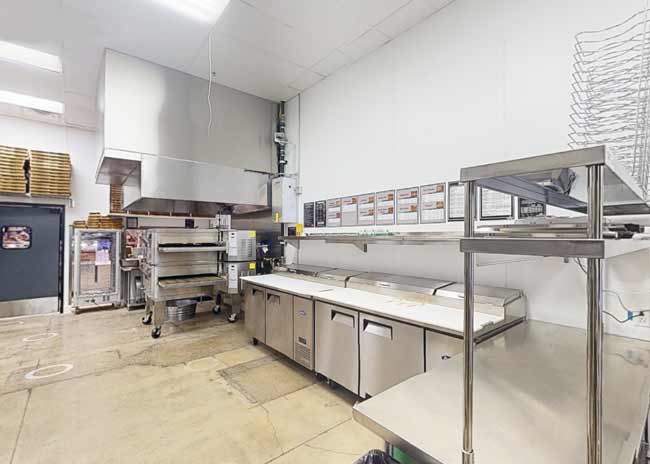 Not surprisingly, Mountain Mike’s relies on pizza tables to produce most of its items, including sandwiches and wings.
Not surprisingly, Mountain Mike’s relies on pizza tables to produce most of its items, including sandwiches and wings.
Single Flow
These self-serve offerings, of course, require some basic restaurant equipment: heat lamps for the pizza, cold tables for the veggies and food shields for everything. The back-of-the-house design also supports these self-serve features by positioning the pass-through window right next to the oven that cooks all of Mountain Mike’s hot offerings.
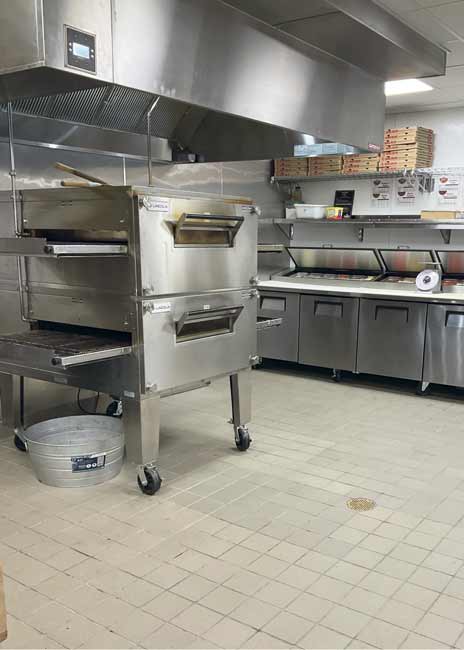 The layout of the kitchen can be straight, U-shaped or L-shaped, but the flow of work remains the same, with all cooked items heading to the double-deck oven.Mountain Mike’s new design included some important changes to the back of the house. These were mostly aimed at creating a tighter, more efficient space. Doing so, says Garrett Snyder, vice president of development, allowed Mountain Mike’s to cut a couple hundred square feet from the back, freeing up more space for the customer experience up front.
The layout of the kitchen can be straight, U-shaped or L-shaped, but the flow of work remains the same, with all cooked items heading to the double-deck oven.Mountain Mike’s new design included some important changes to the back of the house. These were mostly aimed at creating a tighter, more efficient space. Doing so, says Garrett Snyder, vice president of development, allowed Mountain Mike’s to cut a couple hundred square feet from the back, freeing up more space for the customer experience up front.
These savings were achieved through small, practical tweaks. The chain added more vertical shelves along the walls, for example. This allowed Mountain Mike’s to increase its linear shelving space while actually shrinking the square footage of the storage area.
Other efforts focused on reducing steps for staffers working in the kitchen. The new design prioritizes locating the walk-in cooler closer to the production area than before, allowing for quicker restocking throughout the day. Conversely, the dish room and prep area aren’t key to kitchen operations; those can be located basically anywhere in the back of the house in order to create a more efficient kitchen.
This flexibility is a key part of Mountain Mike’s approach to restaurant design, stresses Steven Adyani, vice president of operations. For second-generation locations in particular, the chain’s development team reviews the existing space and helps create a design that takes advantage of existing infrastructure, including HVAC, plumbing and walk-in refrigeration.
“Before we approve a site, we go through a thorough review of the location to make sure it can actually accommodate our minimum requirements for the kitchen. Once it comes in, we are very familiar with it, and we can really help the architect and the franchisee. We team up and create the best possible layout for that second-generation kitchen,” says Adyani.
Mountain Mike’s production area is simple. Every store basically follows the same workflow, but the line where this flow takes place can change from straight to an L-shape or U-shape, depending on the restaurant’s footprint.
The workflow in each location starts with making the pizza dough from scratch. The chain prides itself on serving “pizza the way it oughta be.” In every restaurant, usually starting around 8 a.m., staffers make dough and stretch it into crusts, mix the pizza sauce, cut and slice whole vegetables into topping-friendly forms, and even shred their own cheese.
The line starts with a dust and dock station. Here, the crusts get their initial prep and then are sent down the line to a large pizza assembly station. Unsurprisingly, this space consists of pizza tables with ingredients on top and backup ingredients held in refrigeration below.
The tables also house one of Mountain Mike’s key non-pizza offerings. Here, staff take raw, defrosted chicken wings from the undercounter refrigeration. They sauce and toss the wings before placing them into the oven. Similarly, the pizza tables are also where staff assemble oven-baked sandwiches.
After these tables comes an upright freezer that holds frozen wings, jalapeno poppers and the chain’s mini-churro desserts, all of which get sent to the oven.
Next comes the oven itself. Mountain Mike’s uses a double-deck conveyor unit. This is the only piece of hot-side equipment in the restaurant. When pizza comes out of the oven, it is right next to the pass-through window for the front of the house. Staff then place finished pies in boxes for to-go/delivery orders or easily take the food to the dining rooms’ buffets or to guest tables.
One important variable in kitchen operations, Snyder notes, is how a location manages delivery. While Mountain Mike’s does sell through third-party platforms like DoorDash and Uber Eats, it also has its own delivery system and drivers.
Depending on the store’s footprint, then, these drivers can pick up orders through the front of the house or through a door in the back. When delivery is handled through the back, the chain typically adds extra warming cabinets and extra beverage coolers near the back door to simplify the pickup process.
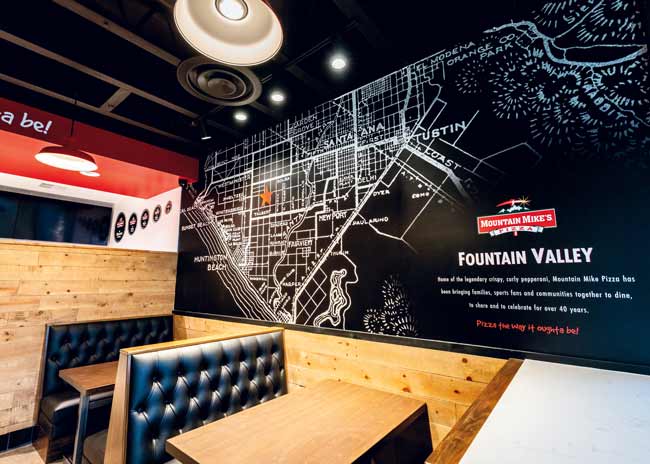 The new design includes upholstered booths and multiple flat-screens. These encourage guests to enjoy their food as dine-in customers.
The new design includes upholstered booths and multiple flat-screens. These encourage guests to enjoy their food as dine-in customers.
Geographic Growth
The creation of this new design is just one part of Mountain Mike’s larger growth initiative. The chain started priming itself for expansion back in 2017, when it was acquired by
Chris Britt and Ed St. Geme, two private equity veterans who now serve as co-CEOs.
Over the past six years, Britt and St. Geme focused on strengthening Mountain Mike’s as a franchisor — a wise move for a concept that is 100% franchised.
The firm has brought in new senior leadership, that includes Metevier, as well as leaders in franchisee recruitment, marketing, store development and operations. The company has also staffed up its corporate team in these areas to better serve existing franchisees and support new ones who come on board.
This approach has been paying off. When Mountain Mike’s was acquired in 2017, it had around 180 locations in four states. Today, the chain has nearly 270 restaurants in six states: Arizona, California, Idaho, Nevada, Texas and Utah. It is set to enter an eighth market, Colorado, in the first half of 2023. The company expects to add an additional 30 stores in 2023, with that number rising about 10% per year for the next few years.
Mountain Mike’s is being very intentional with this growth, says Metevier. The company’s strategy has it moving west to east, which allows the chain to better support franchisees and build brand awareness as it expands. Ultimately, Metevier says, the company wants to become a national chain.
This growth will continue Mountain Mike’s intentional approach to expansion. The chain, Metevier says, isn’t setting an inflated store count target. Instead, it is seeking out franchise partners who have the best chance of success.
In many cases, the company partners with multiunit, multiconcept operators looking to build their portfolios. As it moves into entirely new territories, Mountain Mike’s also seeks to partner with franchisees who can commit to opening multiple stores.
Beyond industry experience, the chain looks for franchisees who share Mountain Mike’s values. Because the chain is community-focused, it wants to partner with people who are involved in their communities. Similarly, franchisees must have the hospitality gene. The ability and desire to deliver a great experience to guests can’t be taken for granted.
This ability is key to Mountain Mike’s strategy and can best leverage the elements and advantages of its new design, Metevier says. “The arcade is additive to the experience. The televisions are additive. The ability to grab beer and wine is additive. We are offering an overall package as opposed to a closet where you go to pick up your pizza and head home.”
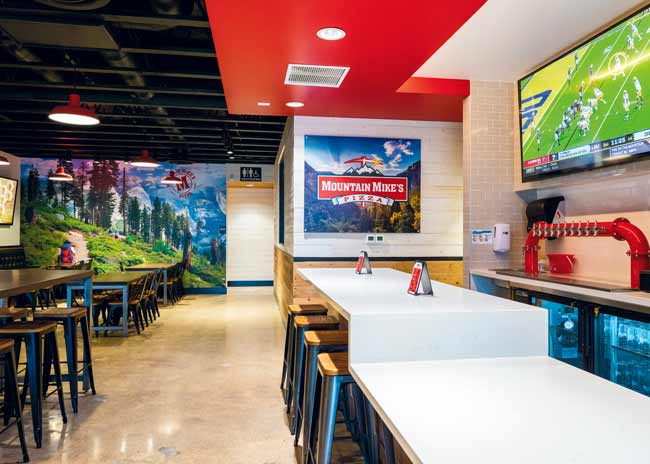 Mountain Mike’s locations include a bar and a video arcade. The company’s leadership wants guests to visit for a game or come with the whole family.
Mountain Mike’s locations include a bar and a video arcade. The company’s leadership wants guests to visit for a game or come with the whole family.
At a Glance
Chain headquarters: Newport Beach, Calif.
Year founded: 1978
Key players:
- Chris Britt, co-CEO & co-owner
- Ed St. Geme, co-CEO & co-owner
- Jim Metevier, president & chief operating officer
- Garrett Snyder, VP of restaurant development
- Steven Adyani, VP of operations
- Carol DeNembo, VP of marketing
Signature menu items: “Mountain-sized” pizzas and “crispy curly pepperoni pizzas”
Number of units: 270
Unit size: 2,200-3,500 sq. ft.: 55% FOH, 45% BOH
Seats per unit: 75
Location type: Inline, endcap, stand-alone
Total system sales: $278 million in 2022 (projection); $254 million in 2021
Average sales: $1.1 million in 2022 (projection); $1.08 million in 2021
Unit growth projections: 30 per year
Check average: $36
Equipment package cost: $125,000-$130,000
Equipment dealers: Avanti Restaurant Solutions, TriMark




